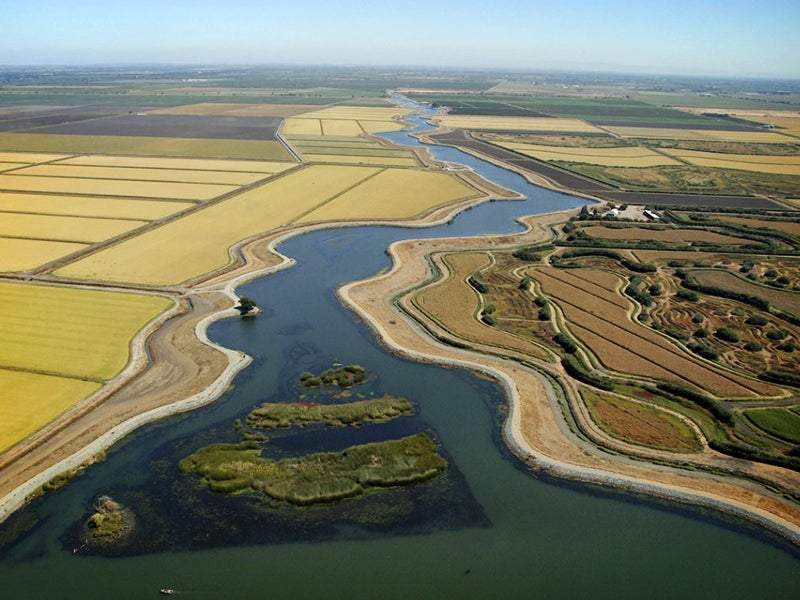Two Tunnels Too Many
Earthjustice is representing Restore the Delta to oppose a massive diversion of fresh water from California’s Delta for Governor Jerry Brown's proposed “Twin Tunnels” project.

This page was published 9 years ago. Find the latest on Earthjustice’s work.
Like the roots of an ancient oak tree, California’s two largest rivers, the Sacramento and the San Joaquin, carve twisting, gnarled channels into the Central Valley as they converge to form the Delta. The Delta occupies over 1,000 square miles of the state’s interior, connecting water flowing from the mountains that surround the valley to the Pacific Ocean via its vast network of channels, sloughs and marshes. The Delta hosts wetland and aquatic ecosystems critical to the well-being of the state’s wildlife and human inhabitants. The health of the San Francisco Bay, into which Delta waters flow, is inextricably linked to the health of the Delta.
Increasing demands for water are undermining the natural balance of these fragile ecosystems. And now a proposal by Gov. Jerry Brown to divert water from the Delta, popularly known as the “Twin Tunnels” project, threatens to cause an all-out ecological disaster in the Delta that would devastate both wildlife and human communities.
If regulators allow this project to proceed, Laotian subsistence fisherman would suffer reduced catches and, even worse, catch fish laden with toxic contaminants. Delta farmers would be left with water too salty to irrigate their crops. Members of the Winnemem Wintu Tribe would lose their spiritual connection to the Delta’s salmon, along with cultural traditions they have maintained for generations.
Beginning with European arrival in the 1800s, the Delta’s settlers transformed the region into a mecca for agricultural production through a vast network of levees and dams. Government-sponsored water projects further sculpted the Delta into a source of water for arid Southern California in the 20th century.
Massive infrastructure projects designed to manage the state’s waterways aren’t new. But as the state’s population continues to grow and climate change diminishes winter snowpack in the Sierra Nevada Mountains, which feeds the state’s rivers and aquifers throughout the year, the Delta is increasingly unable to meet the cumulative demands for water from cities, industry, wildlife and agriculture.
While marketed as a solution to this problem, the Twin Tunnels proposal would in fact further damage an already stressed environment. The project would create two 30-mile-long tunnels 150 feet below the Delta’s surface to funnel massive amounts of fresh water from the Sacramento River where it enters the Delta to pumping stations at the Delta’s southern edge.
While this project might fulfill the desires of powerful agribusinesses and fossil fuel fracking corporations in bone-dry regions of the southern San Joaquin Valley, it would only harm those in the Delta region. These tubes, which would each be large enough to enclose a four-story building, would drain the Delta’s fresh water inflow, causing salt water from the San Francisco Bay to intrude further upstream.
Anyone who tried “freeing” their goldfish into the ocean as a child can imagine what happens next. As the Delta’s ecosystem becomes more brackish—an ongoing problem caused by drought and current excessive diversion of the Delta’s fresh water—the salt threatens native fish and other aquatic species that have evolved in a Delta with dependable fresh water flows and that are already struggling to survive.
Commercial and sport fishing industries would suffer reduced fish populations caused by lack of freshwater flows and resulting increased concentrations of pollutants in Delta channels. And the Delta’s vibrant agricultural community could not be maintained without adequate fresh water. Delta farmers currently take water directly from Delta channels, but the intrusion of salt water far upstream would deny them fresh irrigation water.
Increased salinity would also imperil drinking water supplies for millions of Northern California residents whose home water supplies are currently drawn from the Delta far downstream from where the tunnels would divert fresh water. At best, these communities, which include the economically distressed city of Stockton, would incur enormous costs to clean up and desalinate the degraded water that would result from the tunnels’ operations.
For all of these reasons, Earthjustice is representing the grassroots organization Restore the Delta in ongoing hearings before California’s State Water Resources Control Board that will determine the future of the Twin Tunnels proposal.
If Brown gets the go-ahead for this project, Californians across the state will be left with at least a $15 billion bill for another water infrastructure project that will ultimately do more harm than good.
It’s time to abandon the massive water projects that were the supposed solution to California’s scarce water supplies in the mid-20th century. Instead, we must turn to 21st-century solutions, including groundwater recharge and protection, increased efficiencies in water use, the capture and reuse of urban stormwater and wastewater recycling.
The California Regional Office fights for the rights of all to a healthy environment regardless of where in the state they live; we fight to protect the magnificent natural spaces and wildlife found in California; and we fight to transition California to a zero-emissions future where cars, trucks, buildings, and power plants run on clean energy, not fossil fuels.